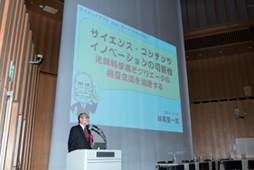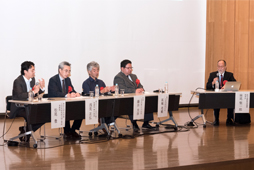What would emerge when scientific research and science fiction cross each other’s path? Inviting experts from different fields such as scientific researchers, technical engineers, writers and venture capitalists, we shared our dreams and discussed possibilities to create a new intellectual field that could arise from the collaboration of science and contents.
「『サイエンス』と、娯楽的要素を含むアート作品を意味する『コンテンツ』。レオナルド・ダ・ヴィンチの時代に最高潮を迎え、以来分化してきた両者を積極的に交流させたらどうなるのでしょうか」。サイエンスとコンテンツの交流の場となる「サイエンス・コンテンツ・イノベーションスタジオ」というアイデアを温めてきた産学連携推進機構理事長の妹尾堅一郎氏がモデレーターとなり、本セッションで、こう呼び掛けました。
“Since the peak in the era of Leonardo da Vinci, 'science' and 'contents', or artworks with entertainment elements, have branched off from one another. But what happens when the two mingle?” Prof. Ken Senoh, President at the Industry-Academia Collaboration Initiative Nonprofit Organization, as the moderator for this session, had gestated the idea of an “innovation studio for science and contents”, whereby science and contents could merge.
複数の分野が交流することで起きるイノベーションになぞらえ、サイエンスとコンテンツが互いに刺激を与え合って、そこから生まれる発想を起点としてベンチャー企業が育つ。そんな世界の実現の可能性について、意見が交わされました。。
Innovation happens from interactions of different fields: Speakers exchanged opinions on how to create a world where entrepreneurs could develop new ideas as a starting point that emerge from mutually inspiring interactions of science and contents.

パネラー4人のうち最初に紹介されたのは人工知能研究の第一人者、松尾豊氏。幼少期は漫画やアニメよりもSF小説に没頭。数学や物理学で表される世界に惹かれ、科学の世界に踏み込み、人間の認識限界を超えたいと人工知能研究の道に。現在は、「ディープ・ラーニング」(脳のように多層の神経ネットワークを組んで学習させる方法)と強化学習を組み合わせて、画像認識技術の向上に携わっています。人工知能が社会で使われていく中で、「一体どういう社会をつくりたいのか」を議論するため、「どういう社会があり得るのか」をコンテンツに描いてほしいと期待しています。
The first panelist introduced was Dr. Yutaka Matsuo, the leading expert in artificial intelligence research. Having devoted his childhood to science fiction novels, instead of comic books and animated cartoons, he began to find interests in the world expressed by mathematics and physics. Eventually, he chose his career in the world of science, specifically artificial intelligence, as he wanted to go beyond the limitations of human recognition. Currently, he is involved in the development of image recognition technologies, by combining the reinforcement learning and so-called "deep learning", a learning method by programming a multilayered neural network like a human brain. He expects contents creators to illustrate what kind of societies could exist, in order to discuss what kind of a society should be created, with artificial intelligence.
続いては、富士フイルムの研究者を経て現取締役の浅見正弘氏。幼少期は化石採集、天体観測に興味を持つ理科少年でした。『少年少女宇宙科学冒険全集』で外宇宙の知的生命体の存在に衝撃を受け、以来、天文にのめり込んだとのこと。天文写真が好きだったこともあり、写真会社へ就職。SFは単なるフィクションではなく、SFでいろいろな可能性を考えることが重要だと語りました。
The next panelist was Mr. Masahiro Asami, the current Director and former researcher at FUJIFILM. When he was small, he was interested in collecting fossils and astronomical observations. In particular, he became completely devoted to astronomy after he was shocked by the existence of outer space intelligent life, reading stories from "Shonen Shojo Uchu-Kagaku Boken Zenshu (SF Adventure Series for Young Adults)." He then chose to work at a photography company, partly because he was intrigued by astronomical photography. He told the audience the importance to absorb scientific fiction not just as pure fiction, but rather as various possibilities for the future.
コンテンツクリエーターの側からはSF作家の藤井太洋氏が招かれました。奄美大島で過ごした少年時代、サトウキビの品種改良から科学技術の進歩を目の当たりにしたほか、繰り返し読んだ手塚治虫の『火の鳥』や『ブラック・ジャック』に影響を受けたとのこと。上京後、コンピューターの世界にのめり込んでいきましたが、東日本大震災後、混乱する社会を目にし、放射線の正しい知識を提供したいと筆を執り、デビュー作『Gene Mapper』を発表。以来、SF作家の道に進みました。どんな社会環境になったとしても「人間が幸せに生きたいという気持ちは必ず残っていると信じて作品を書き続けている」と語ります。
Mr. Taiyo Fujii, a science fiction writer, was invited to represent as a content creator. He began sharing his childhood memories back in Amami Oshima, where he learned about technological advancements through the breed improvement of sugar canes. He also repeatedly read "Phoenix" and "Black Jack" by Osamu Tezuka, whichboth influenced him. Since he came to Tokyo, he has focused on learning about computers, but after the Great East Japan Earthquake in 2011 and seeing the chaos of society, he decided to share the factual stories on radiation and presented his first work "Gene Mapper" as a science fiction writer. "I continue to write and produce work because I believe that people will continue to wish for a happy life" no matter what happens to society, said Mr. Fujii.
4人目は、ベンチャーキャピタルビジネスの世界から高槻亮輔氏。同氏も少年時代は静岡県で郊外の川や野山で遊んで過ごす一方で、ガンダムやスター・ウォーズシリーズ、『2001年宇宙の旅』など、宇宙に関わる作品の影響を強く受けたといいます。大学は経済学部でコンピューターのプログラムを書く日々を送り、銀行に就職。みずほ銀行統合時の基盤作りに従事したのち、2001年にベンチャーファンドの世界へ。「新しい事業、ビジネスを具体化して世の中に広める」ことを目標にベンチャー企業を支えています。
The fourth panelist was Mr. Ryosuke Takatsuki, a venture capitalist. He was also inspired by toys like Gundam and stories related to space such as the Star Wars series, and "2001: A Space Odyssey" while he used to play in the rivers and mountains of Shizuoka during his childhood. Having majored in economics at university, he used to write computer programs and started working for a bank after graduation. After being involved in building the foundation upon the integration of Mizuho Bank, he joined a venture fund in 2001. He now supports ventures: His vision is to "create and expand new businesses in society.”
パネルディスカッションでの焦点は、サイエンスとコンテンツが相互に交流する中でのコンテンツの役割。技術が発達した社会に「目的は?」と問い掛けるのは松尾氏。同氏はそれを描くのがコンテンツだと言います。人工知能の発達とは問題解決能力である「手段(how)」の能力向上を意味するのに対して、「人間は知能+生命」であり、問題解決の他に「目的(what)」も持ち合わせていると言います。人工知能が進んだ社会で何を目的にして何を選択するのか。コンテンツが科学技術の進んだ世界を具体化して描くことで、社会の理想像の議論が促進され、目指すべき社会像が見えてくると松尾氏は説きました。
The focus of the panel discussion was the role of contents in the mutual exchange between science and contents. "What is the purpose" in society with highly advanced technologies? asked Dr. Matsuo. He said that it is the creator’s role to produce contents answering such questions. The development of artificial intelligence means the improvement of "ways (how)" for problem-solving. On the other hand, "humans have both intellect and lives", meaning that they also have "purposes (what)" in addition to problem-solving capability. In a society with highly advanced artificial intelligence, comes the question, what we choose and for what purposes? Dr. Matsuo explained, the more contents that show us how the world with advanced technologies look like, people are more encouraged to discuss an ideal society and imagine what it would look like.
社会の理想像の話は企業にも及びました。富士写真フイルム(2005年当時)は写真業界の衰退を受け、「人間にとって一番大事なもの」に技術で貢献することを使命に、化粧品や医薬品業界へと乗り出したと浅見氏は語ります。新しい技術を伴うベンチャーには「社会性だ」「弊害だ」ときれいごとを言っていられない期間がつきものです。しかし、そういった時期にいつ実現するかわからない計画を「正しい金融」で支えたいと話す高槻氏。短期的な儲けよりも、人間や社会にとっての価値を一義に据える企業の考えが垣間見られました。
Panelists also talked about an ideal society from a business perspective. Mr. Asami shared a story at then-Fuji Photo Film, around 2005: Given the decline in the photographic industry, the company decided to endeavor in cosmetics and pharmaceutical industries, with a mission to contribute to "the most important thing to humans" using their technologies. Many ventures that use new technology, often have to face criticisms about its applicability to society and potential harms. However, Mr. Takatsuki said that he would like to support such plans that nobody could guarantee success, using the "right financing” particularly during such a time when entrepreneurs faced criticism. From this discussion, we could see a glimpse of corporate missions and roles that prioritize values for humans and society over the short-term profits.

「コンテンツは物事の発想を引き出すアブダクション(abduction)の加速ツールだと考える」と述べたのは浅見氏。科学の方法論には「帰納法」と「演繹法」の2種類がありますが、同氏によれば、仮説を立てる発想の段階はこの2つには含まれません。研究がうまく進まないとき、仮説が「ぽっと入った」(=アブダクション)ことで進歩が生まれると言います。
“Contents can be used as a tool to accelerate abduction, to draw a new idea,” said Mr. Asami. There are two methodologies in science, namely "induction" and "deduction", but according to him, neither of them includes the phases of making hypotheses. When research is not going well, the progress occurs from the hypothesis to emerge via abduction.
「事実から仮説を立てるサイエンスに対して、コンテンツが枠を取り払った自由な発想でアブダクションを刺激するのではないでしょうか。また(コンテンツ自体だけでなく)SF的になった現実そのものが、新しい事業や問題解決につながることもあり得ます」と浅見氏は見解を語ります。
“Whereas hypotheses are developed based on facts, contents free from such boundaries may help stimulate abduction. It is also possible that (not only the contents per se) the Sci-Fi-like realities bring new business opportunities and solutions to a problem", Mr. Asami shared his views.
また藤井氏は、自らのSF作品について「科学のプロセスに対してどれだけ貢献できるか」を意識して書いていると言います。実際、同氏の著作『オービタル・クラウド』に登場する「導電性テザー」に、JAXA(宇宙航空研究開発機構)から問い合わせが来たという話も紹介しました。同様に例えば、SF作家のアーサー・C・クラークの著作には通信衛星やレコメンデーション機能(おすすめ機能)を想起させるような場面もあるといいます。藤井氏は「このようなことは狙ってできることでない」と断りつつも、サイエンスの進む方向に示唆を与えるようなリードパスを出す役目を「やれたら光栄」と夢を語りました。
Mr. Fujii mentioned that he had kept in mind the possible contributions of his work to scientific processes when writing. He mentioned that he was indeed contacted by JAXA about "electrically conductive tether," which appeared in his work "Orbital Cloud." Similarly, he also said that there were scenes that reminded the audience of communication satellites and “recommendation” functions in the work of Arthur C. Clarke, a science fiction writer. Mr. Fujii says, “While I did not and cannot make these things happen intentionally, I would be honored” to lead or suggest the direction of science.
一方でSF小説は論文に似ている、と松尾氏は言います。論文がその論旨を正当化するとき、「参考文献を引く」、「実験をする」、「さまざまな知見との整合的な説明をする」の3種類の方法があります。『2001年宇宙の旅』のような論理が整合的で説得力が担保されたSFは、実験を行わない論文の形と非常によく似ていると同氏は指摘しました。
Dr. Matsuo, on the other hand, mentioned that science fictions resembled academic papers. There are three ways to support an argument in a paper; the first one is to cite other literature, the second is to conduct an experiment, and the third is to explain the logical coherence regarding different perspectives. He pointed out that highly cohesive and convincing science fictions like "2001: A Space Odyssey" were very similar to academic papers without experiments.
藤井氏の書く小説では、その世界に納得しつつ、どんな社会状況でも人が幸せに生きようとする姿を見て「最後に希望があるんだ」と共感できる。だからこそ藤井氏の作品は受け入れられるのでは、と妹尾氏は分析していました。
Prof. Senoh observed that people accepted Mr. Fujii's novels because just as much as they could understand the world, they could also sympathize with the characters trying to live happily under any circumstances and felt that there was hope in the end.
高槻氏はサイエンスとコンテンツだけでなく、ベンチャー起業家とコンテンツ間の交流にも可能性を見いだしました。「ベンチャーの世界では費用などの問題で、なかなか広告が打てないが、世間がコンテンツによって(ベンチャーの技術や発想を)肯定的に捉えてくれれば良いバックアップになる。コンテンツクリエーターに近いレベルでベンチャー創業者は実現したい未来を明確に描いている。彼らに機会を与えれば面白い連携が取れるかもしれない」と期待しました。
Mr. Takatsuki believed that interaction is not only between scientists and content creators but also can be between entrepreneurs and content creators. "It is difficult for startups to advertise because of the lack of funding, but contents creators can help them to share positive stories on new technologies and ideas to the general public, people can support new ventures. Just like contents creators, entrepreneurs also have visions for the future. There might be interesting collaboration opportunities," said Mr. Takatsuki.
藤井氏、浅見氏、松尾氏の三者も三様に、サイエンスとコンテンツが交流する未来へ思いを馳せました。最後に会場の参加者に向かって妹尾氏が、「相互交流を大いにやるべきと励ましてくれる方は拍手をお願いします」と呼び掛けると、会場からは多くの拍手が送られました。同氏が構想した「サイエンス・コンテンツ・イノベーションスタジオ」の実現も遠くはないかもしれません。
Mr. Fujii, Mr. Asami, and Dr. Matsuo all shared their vision for the future where science and contents meet. At the end of the discussion, Prof. Senoh called out: "Please offer us an applause if you think the mutual collaboration [between science and contents] sounds magnificent, and encourage us to do more!" There was a full round of applause from the audience. His visions on "Innovation Studio for Science and Contents" may be realized in the near future.
「コンテンツによって目指したい社会像が明確になる」というお話が心に残りました。正しい科学知識を基にコンテンツを描くこと、研究者側が業績を一般に周知することは、科学の分野に対する市民の理解や参加を促進させるはず。そして、一般も巻き込んだ「目指したい社会像」の議論は社会構造のイノベーションにもつながるのではないでしょうか。サイエンスとコンテンツ間に留まらず、交流の効果が市民にも波及することを期待します。(足立理央)
Personally, the statement "contents (creators) can help (people) visualize the ideal society" has struck me the most. If the contents were created based on the right scientific knowledge and researchers made their accomplishments known to the public, people will understand more and participate more in science. Discussions on "an ideal society" among citizens can also lead to innovation in the social system. I hope that the effect of mutual exchanges between science and contents do not just stay there but will also influences the general public. (Rio Adachi)